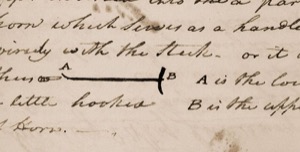January 23, 1806
[Lewis]
This morning dispatched Howard and Warner to the Camp of the Saltmakes for a supply of salt. The men of the garison are still busily employed in dressing Elk's skins for cloathing, they find great difficulty for the want of branes; [1] we have not soap to supply the deficiency, nor can we procure ashes to make the lye; none of the pines which we use for fuel affords any ashes; extrawdinary as it may seem, the greene wood is consoomed without leaving the residium of a particle of ashes.—
The root of the rush [2] used by the natives is a sollid bulb about one inch in length and usually as thick as a man's thumb, of an ovate form depressed on two or more sides, covered with a thin smothe black rind. the pulp is white brittle and easily masticated either raw or roasted the latter is the way in which it is most usually prepared for uce. this root is reather insipid in point of flavour, it grows in greatest abundance along the sea coast in the sandy grounds and is most used by the Killamucks and those inhabiting the coast. each root sends up one stock only which is annual, the root being perenniel. the bulb is attatched to the bottom of the caulis or stem by a firm small and strong radicle of about one Inch long; his radicle is mearly the prolongation of the caulis and decends perpendicilarly; a little above the junction of this radicle with the caulis, the latter is surrounded in a whorl with a set of small radicles from 6 to 9 inches long which are obliquely descending. the caulis is celindric erect hollow and jointed, and is about the size or reather larger than the largest quill. it rises to the hight of 3 or 4 feet, not branching nor dose it either bear flower or seed that I can discover tho' I am far from denying that it dose so sometimes, but I have not been able to discover it. the stem is rough like the sand rush and is much like it when green or in it's succulent state. at each joint it puts out from twenty to thirty long lineal stellate or radiate & horizontal leaves which surround the stem. above each joint about half an inch the stem is sheathed like the sand rush.
[Clark]
This morning dispatched Howard & Werner to the Camp of the Salt makers for a Supply of Salt. the men of the garrison are Still busily employed in dressing Elk Skins for cloathing, they fine great dificuelty for the want of branes; we have not Soap to Supply the deficiency, nor can we precure ashes to make the lye; none of the pine which we use for fuel afford any ashes; extrawdinary as it may seem, the green wood is cosumed without leaveing the risideum of a particle of ashes.— [3]
The root of the rush used by the nativs is a Solid bulb about one inch in length and usially as thick as a mans thumb, of an ovel form depressed on two or more Sides, covered with a thin black rine. the pulp is white brittle and easily masticated either raw or rosted, the latter is the way it is most commonly prepared for use. this root is reather insippid in point of flavour, it grows in the Greatest abundance along the Sea coast in the wet Sandy grounds and is most used by the Kil á mox and those inhabiting the Sea coast. each root Sends up its Stalk which is annual, the root being perennial. the bulb is atached to the bottom of the Stem by a firm Small and Strong radicle which is mearly the prolongation of the Stem which is hollow and jointed and is rather larger than the largest quill. it rises to the hight of 3 or 4 feet, not branching no does it either bear flower or Seed that I could discover tho I am far from denying that it does So Sometimes, and perhaps every year, but I have not been able to discover it, the Stem is rough like the Sand rush, and it's much like it when green, at each joint it puts out from 20 to 30 radiate & horizontal leaves which Surrounds the Stem. above each joint about half an inch the Stem is Shethed like the Sand rush.
The instruments used by the nativs in digging their roots is a Strong Stick of three feet and a half long Sharpened at the lower end and its upper inserted into a part of an Elks or buck's horn which Serves as a handle; Standing transvirsely in the Stick— or it is in this form as thus [4] A is the lower part which is a little hooked B is the upper part or handle of Horn.—
[Ordway]
Thursday 23rd a little Thunder and hail in the course of last night 2 men [5] Set out to go over to the Salt Camps after Some Salt. high wind &C—
[Gass]
Thursday 23rd. We had a fine clear cool morning, and two men [6] were sent to the salt works. The day continued pleasant until about four o'clock in the afternoon, when the weather became cloudy, and it began to rain.
[Whitehouse]
Thursday Janry 23d We had during last night thunder & some hail Showers. two of our Men [7] were sent down to the Camp for Salt. It rained & we had high wind during this day.—



